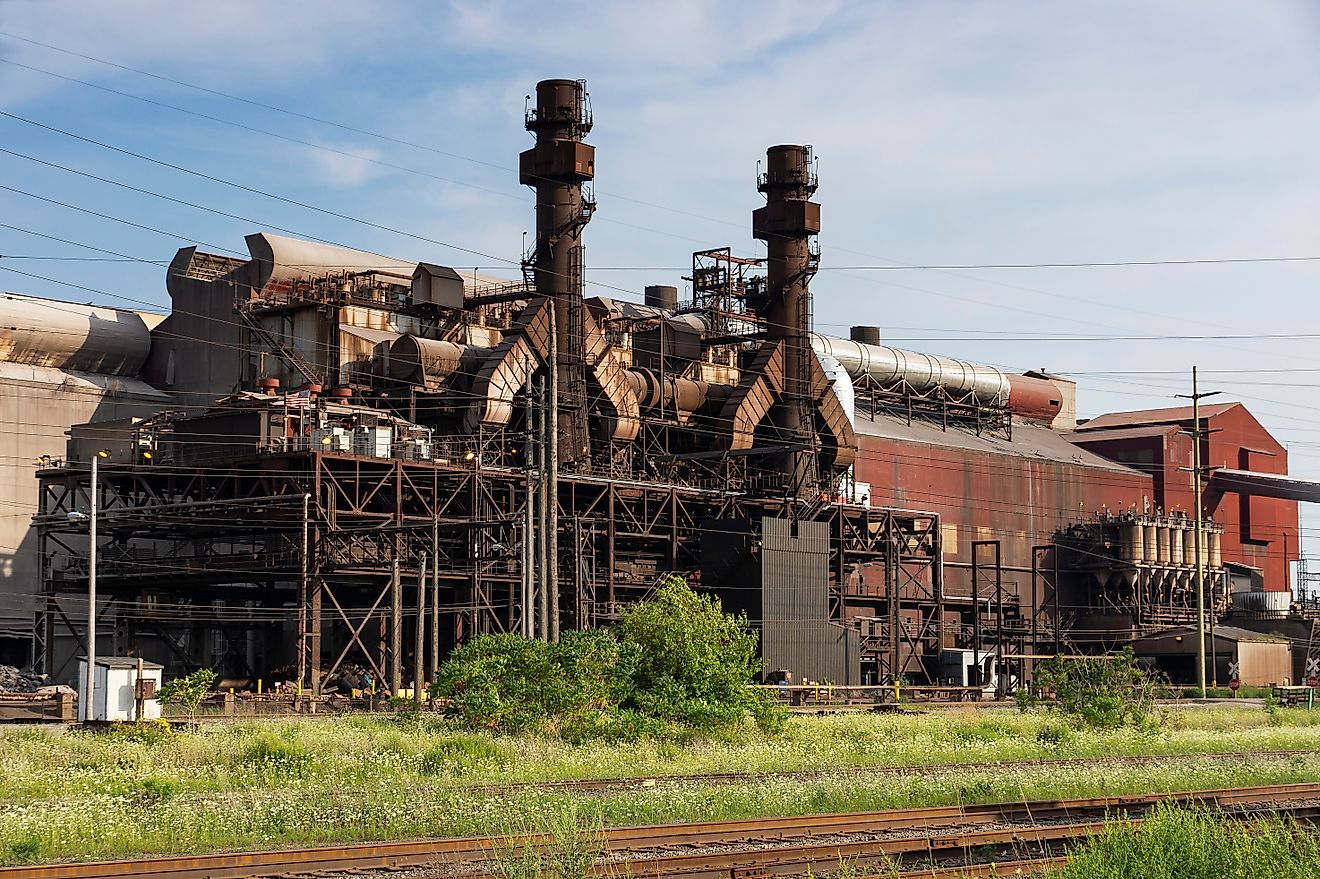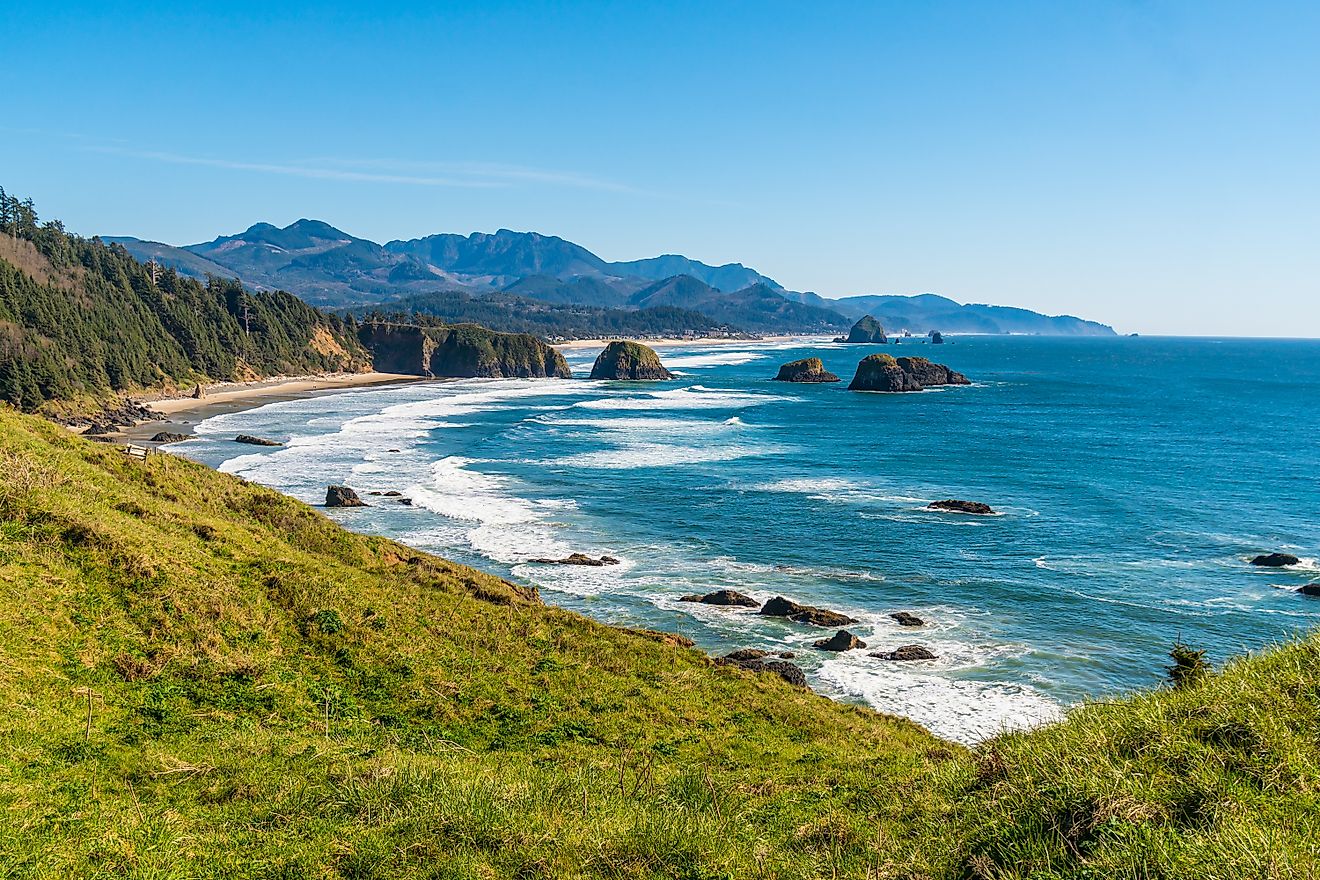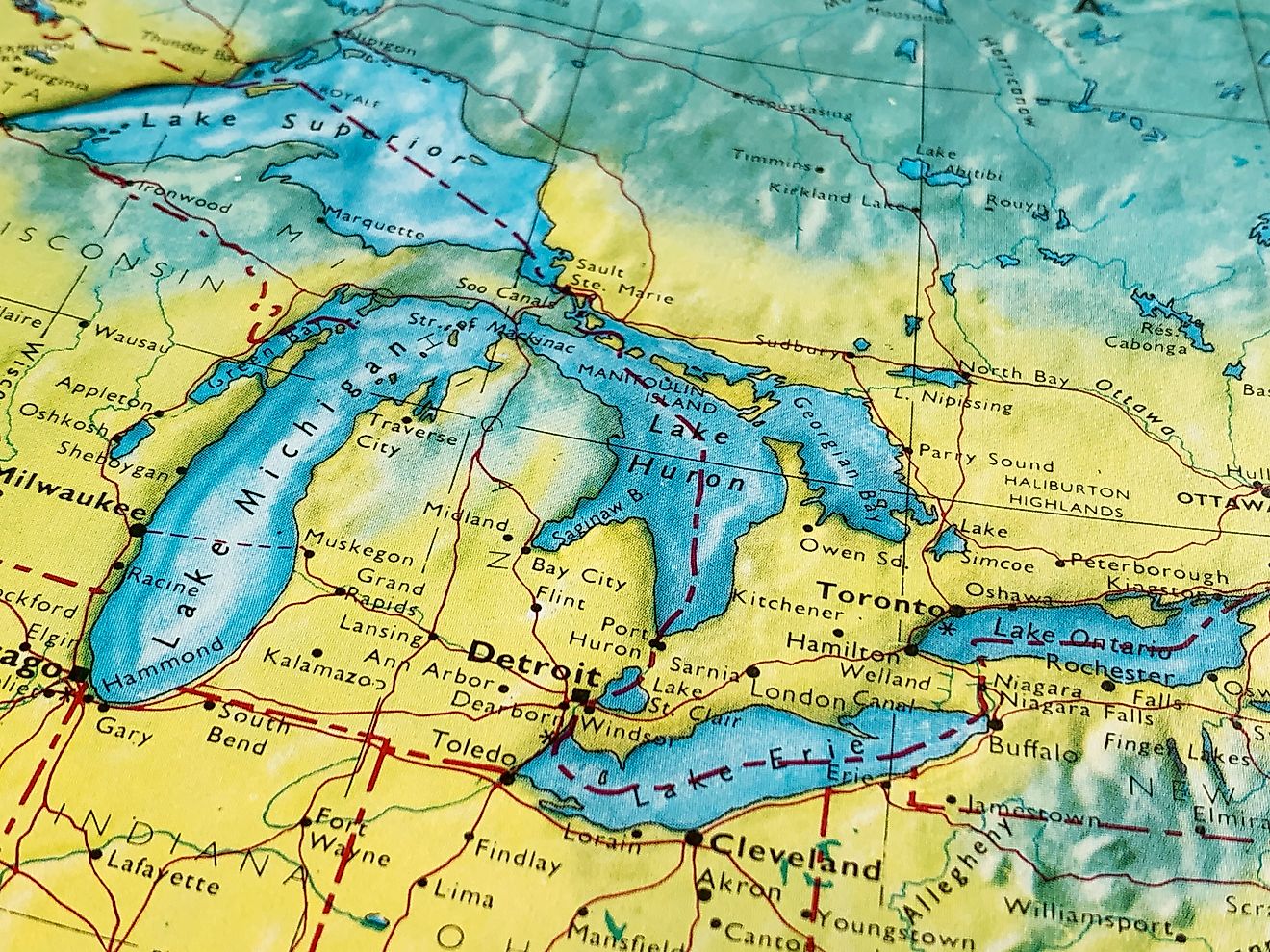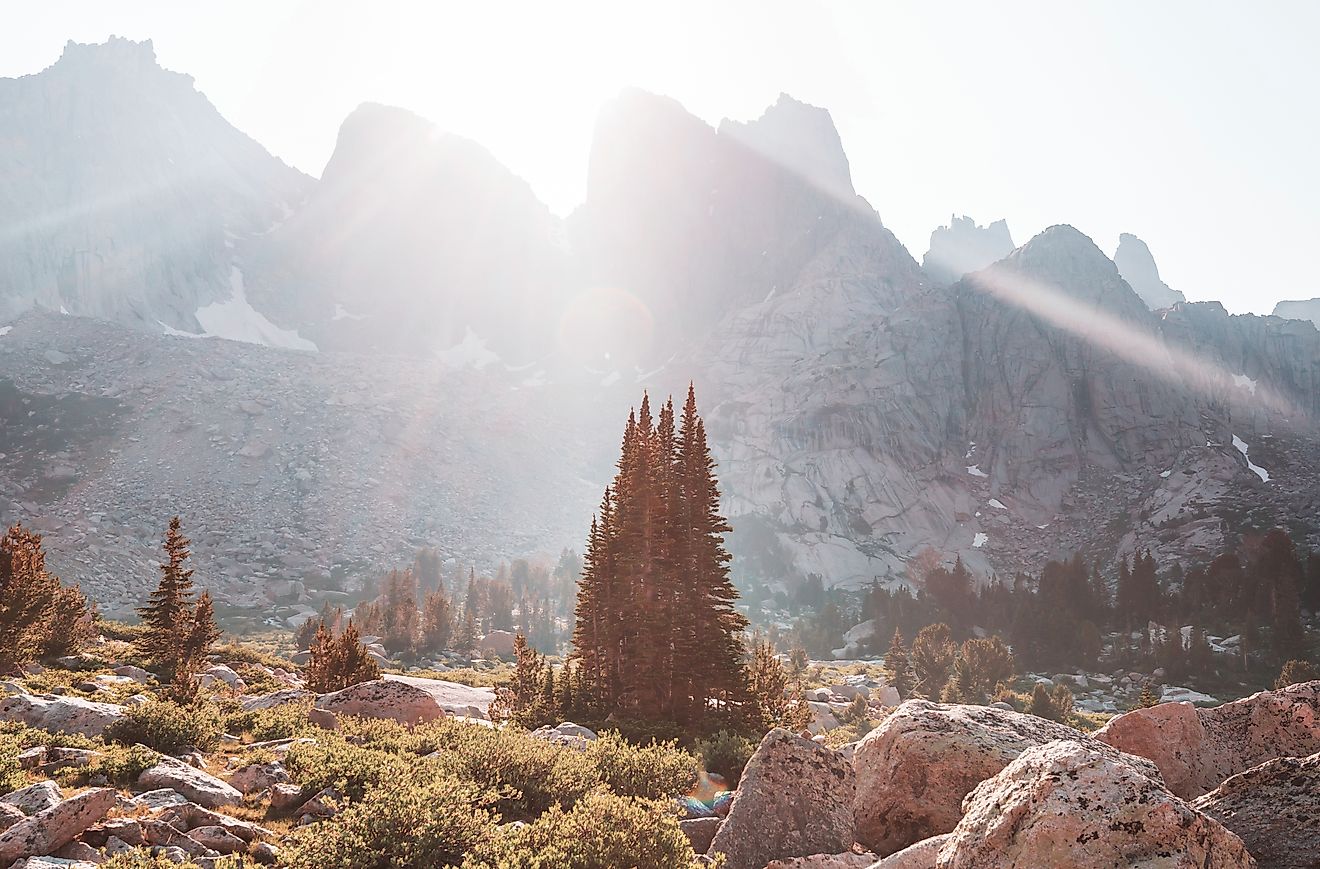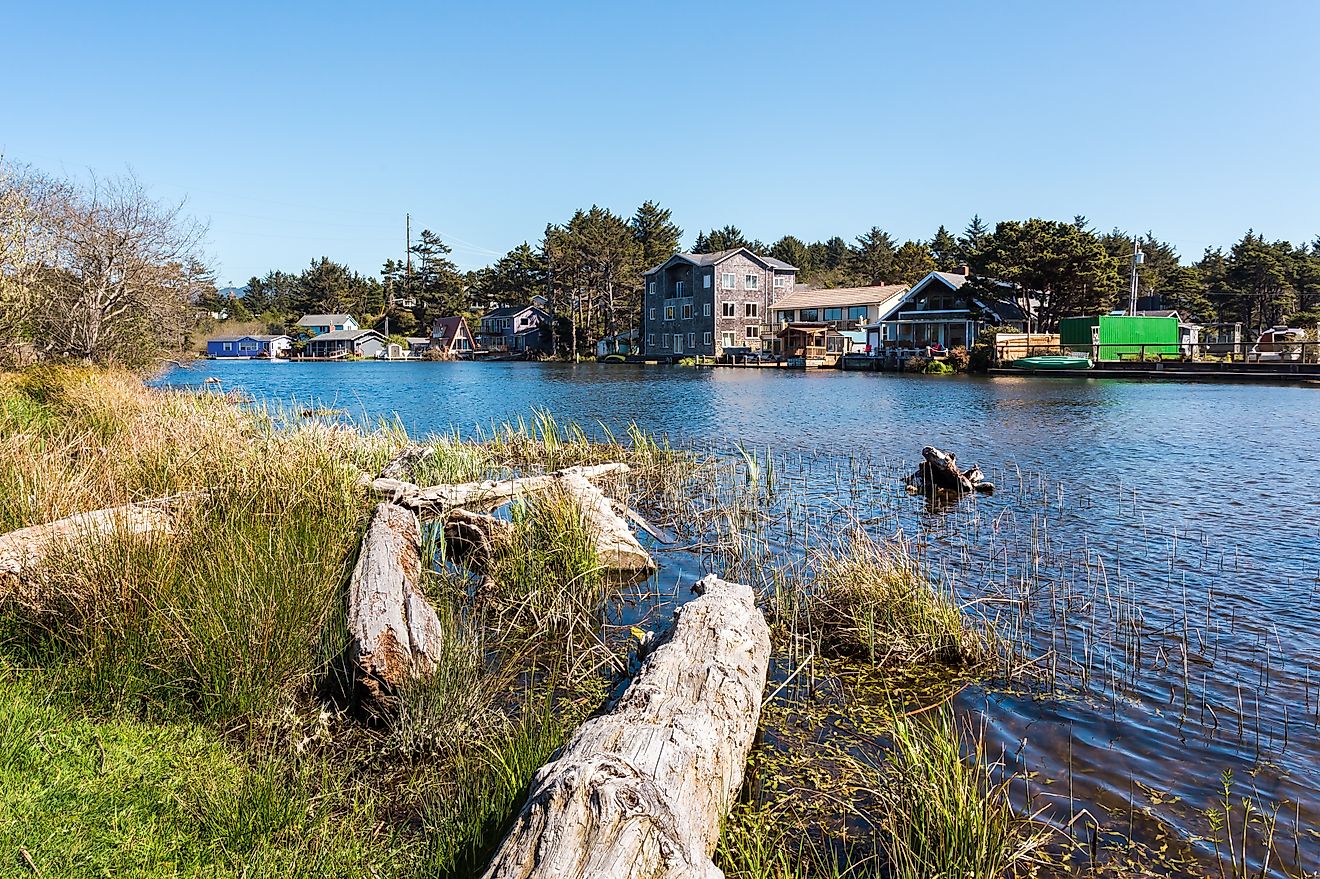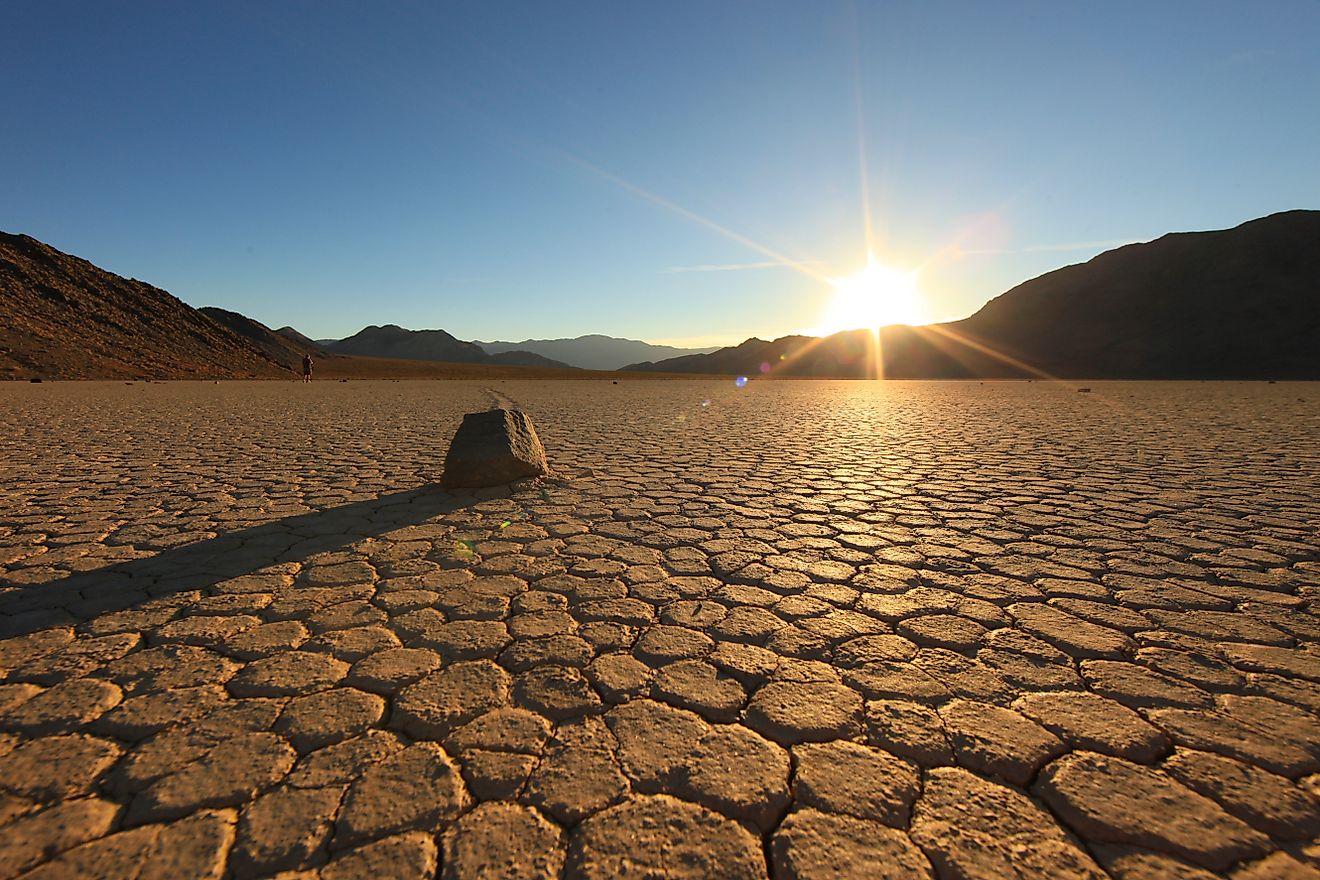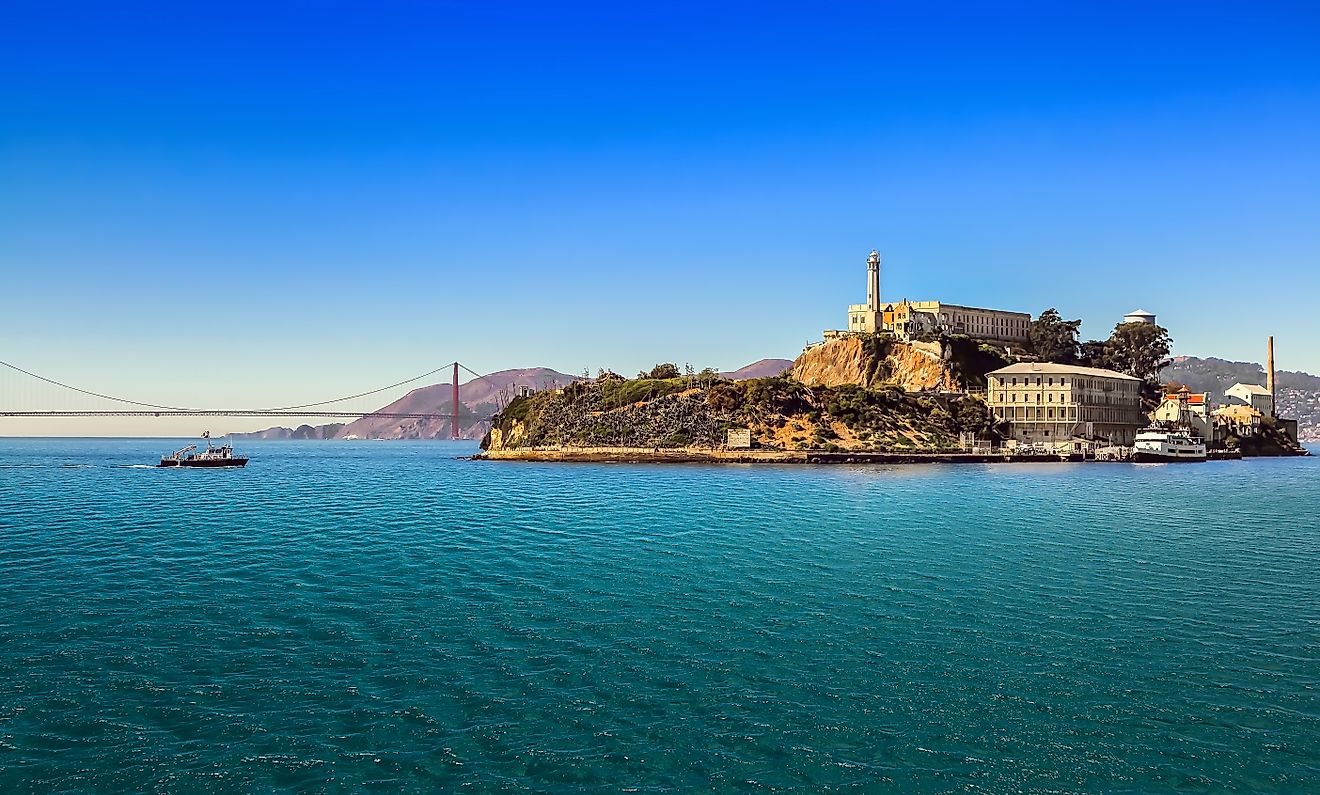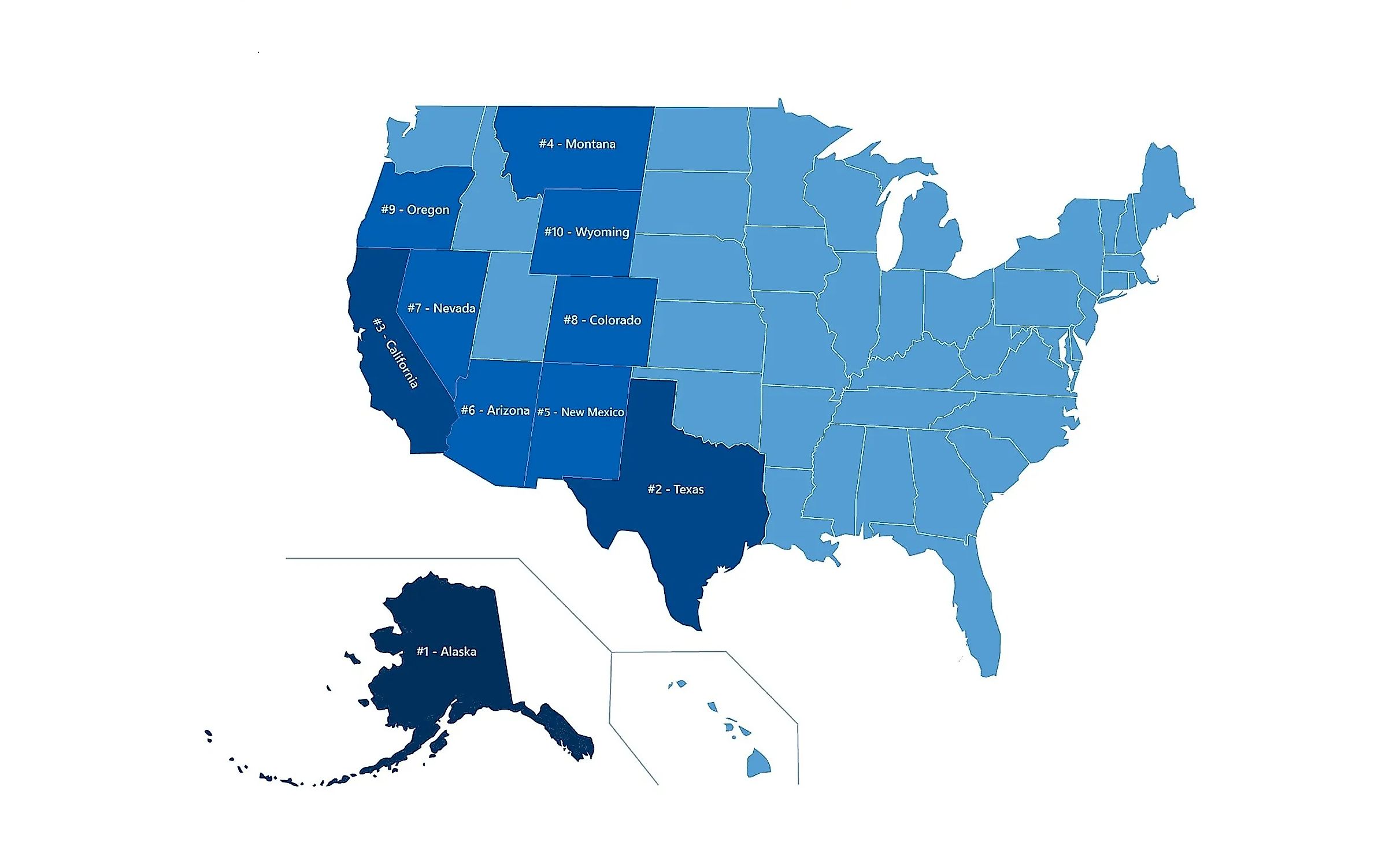
US States By Size
The United States stretches across a remarkable span of the globe, covering a wide range of climates, landscapes, and ecosystems. From the icy reaches of Alaska to the tropical shores of Hawaii, the US includes 50 states—48 of which form a connected block on mainland North America, while Alaska and Hawaii stand apart in the Pacific. Within this diverse nation, state sizes vary dramatically, offering a unique lens through which to explore America's geography.
Depending on how you measure it—by total area, land area, or water area—the rankings of the states can change significantly. Some states boast large expanses of inland lakes, rivers, or coastal waters that inflate their overall size, while others are dominated almost entirely by dry land. For example, Alaska ranks as the largest state by a massive margin, thanks not only to its sheer landmass but also to its extensive water coverage. Meanwhile, Rhode Island remains the smallest, barely larger than some American counties.
When comparing US states by size, it’s important to understand what’s being measured. Land area reflects habitable space, while total area includes bodies of water—an important distinction for states with large coastal regions, river systems, or inland lakes. These differences highlight the incredible geographical diversity of the country, from the sprawling deserts of the Southwest to the dense forests of the Pacific Northwest and the vast wetlands of the Southeast.
Here is a break down of the US states ranked by total area, offering a clearer view of how each state fits into the larger map of America. Whether you're planning a cross-country trip, studying geography, or simply curious, this ranking reveals just how vast—and how varied—the United States truly is.
US States By Size
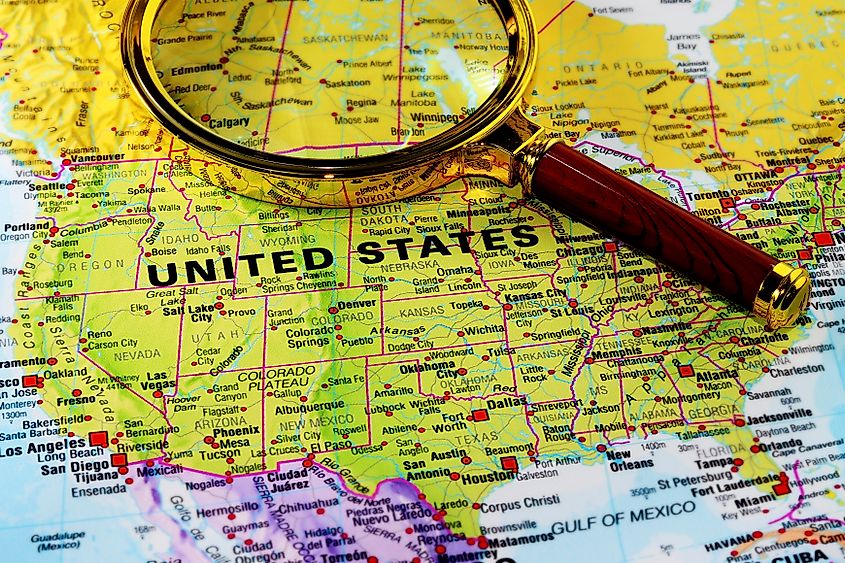
| Rank | State | Total Area (km2) | Land Area (km2) | Water Area (km2) |
|---|---|---|---|---|
| 1 | Alaska | 1,723,337 | 1,477,953 | 245,384 |
| 2 | Texas | 695,662 | 676,587 | 19,075 |
| 3 | California | 423,967 | 403,466 | 20,047 |
| 4 | Montana | 380,831 | 376,962 | 3,862 |
| 5 | New Mexico | 314,917 | 314,161 | 757 |
| 6 | Arizona | 295,234 | 294,207 | 1,026 |
| 7 | Nevada | 286,382 | 284,332 | 2,048 |
| 8 | Colorado | 269,837 | 268,875 | 962 |
| 9 | Oregon | 254,806 | 248,849 | 6,177 |
| 10 | Wyoming | 253,600 | 251,470 | 1,864 |
| 11 | Michigan | 250,487 | 146,435 | 104,052 |
| 12 | Minnesota | 225,163 | 206,232 | 18,930 |
| 13 | Utah | 219,882 | 212,818 | 7,064 |
| 14 | Idaho | 216,443 | 214,045 | 2,398 |
| 15 | Kansas | 213,100 | 211,754 | 1,346 |
| 16 | Nebraska | 200,330 | 198,974 | 1,356 |
| 17 | South Dakota | 199,729 | 196,350 | 3,379 |
| 18 | Washington | 184,661 | 172,119 | 12,542 |
| 19 | North Dakota | 183,108 | 178,711 | 4,397 |
| 20 | Oklahoma | 181,037 | 177,660 | 3,377 |
| 21 | Missouri | 180,540 | 178,040 | 2,501 |
| 22 | Florida | 170,312 | 138,887 | 31,424 |
| 23 | Wisconsin | 169,635 | 140,268 | 29,367 |
| 24 | Georgia | 153,910 | 148,959 | 4,951 |
| 25 | Illinois | 149,995 | 143,793 | 6,202 |
| 26 | Iowa | 145,746 | 144,669 | 1,077 |
| 27 | New York | 141,297 | 122,057 | 19,240 |
| 28 | North Carolina | 139,391 | 125,920 | 13,471 |
| 29 | Arkansas | 137,732 | 134,771 | 2,961 |
| 30 | Alabama | 135,767 | 131,171 | 4,597 |
| 31 | Louisiana | 135,659 | 111,898 | 23,761 |
| 32 | Mississippi | 125,438 | 121,531 | 3,907 |
| 33 | Pennsylvania | 119,280 | 115,883 | 3,397 |
| 34 | Ohio | 116,098 | 105,829 | 10,269 |
| 35 | Virginia | 110,787 | 102,279 | 8,508 |
| 36 | Tennessee | 109,153 | 106,798 | 2,355 |
| 37 | Kentucky | 104,656 | 102,269 | 2,387 |
| 38 | Indiana | 94,326 | 92,789 | 1,537 |
| 39 | Maine | 91,633 | 79,883 | 11,750 |
| 40 | South Carolina | 82,933 | 77,857 | 5,076 |
| 41 | West Virginia | 62,755 | 62,361 | 394 |
| 42 | Maryland | 32,133 | 25,314 | 6,819 |
| 43 | Hawaii | 28,311 | 16,638 | 11,672 |
| 44 | Massachusetts | 27,337 | 20,306 | 7,032 |
| 45 | Vermont | 24,923 | 23,957 | 989 |
| 46 | New Hampshire | 24,214 | 23,186 | 1,028 |
| 47 | New Jersey | 22,591 | 19,047 | 3,544 |
| 48 | Connecticut | 14,357 | 12,559 | 1,798 |
| 49 | Delaware | 5,130 | 5,047 | 1,399 |
| 50 | Rhode Island | 3,114 | 2,678 | 438 |
10 Largest US States

Alaska, one of the last two states to join the Union, stands as the largest US state by a wide margin in both total and land area. Spanning an estimated 1.7 million square kilometers, it accounts for roughly 17% of the entire United States' total area. Remarkably, Alaska is larger than the combined size of the next three largest states. On a global scale, it ranks as the world’s seventh-largest country subdivision. Of its vast expanse, about 1.5 million square kilometers—or 86%—is land, with the remainder consisting of lakes, rivers, and coastal waters.
Texas, located in the South Central region of the United States, ranks as the second-largest state by total area. It spans approximately 695,662 square kilometers, with a vast majority—about 676,587 square kilometers or 97.3%—made up of land. Water bodies account for the remaining 2.7%, covering around 19,075 square kilometers.
California, the most populous state in the US, ranks as the third-largest by total area, covering approximately 423,970 square kilometers. Of this, 403,466 square kilometers are land, making it the third-largest in the country in terms of land area. The state also boasts a water area of 20,047 square kilometers.
Montana ranks as the fourth-largest state in the US, with a total area of approximately 380,800 square kilometers, or about 4% of the nation's total area. The state's land area makes up the vast majority—99%, or roughly 376,962 square kilometers. Its water bodies cover about 3,862 square kilometers, placing Montana 26th among states by water area.
New Mexico, the fifth-largest state, spans approximately 314,917 square kilometers, with 99.8% of it being land. As a result, it ranks as the second-smallest state by water area, covering just 757 square kilometers.
Arizona, the sixth-largest state by total area, covers 295,234 square kilometers. Its land area of 294,207 square kilometers makes up 99.7% of the state's total area.
Nevada, the seventh-largest state, spans a total area of 286,382 square kilometers, representing about 3% of the U.S. total area. Its land area covers approximately 284,332 square kilometers, or 99.3% of the state's total.
Colorado ranks as the eighth-largest state by total area, covering 269,837 square kilometers, or roughly 2.7% of the nation's total area. Its land area totals 268,875 square kilometers (99.6%), with a water area of 962 square kilometers, making it the 44th largest in the US by water area.
Oregon is the ninth-largest state by total area and the 10th-largest by land area. It spans approximately 254,806 square kilometers, with 248,849 square kilometers (97.6%) of that being land. The state ranks 20th in water area, covering 6,177 square kilometers.
Wyoming, the 10th-largest state by total surface area at 253,600 square kilometers, has a slightly larger land area than Oregon, covering 251,470 square kilometers. Its water area spans 2,130 square kilometers, making it the 37th largest in the US.
| Rank | State | Total area (km2) |
|---|---|---|
| 1 | Alaska | 1,723,337 |
| 2 | Texas | 695,662 |
| 3 | California | 423,970 |
| 4 | Montana | 380,800 |
| 5 | New Mexico | 314,917 |
| 6 | Arizona | 295,234 |
| 7 | Nevada | 286,382 |
| 8 | Colorado | 269,837 |
| 9 | Oregon | 254,806 |
| 10 | Wyoming | 253,600 |
10 Smallest US States
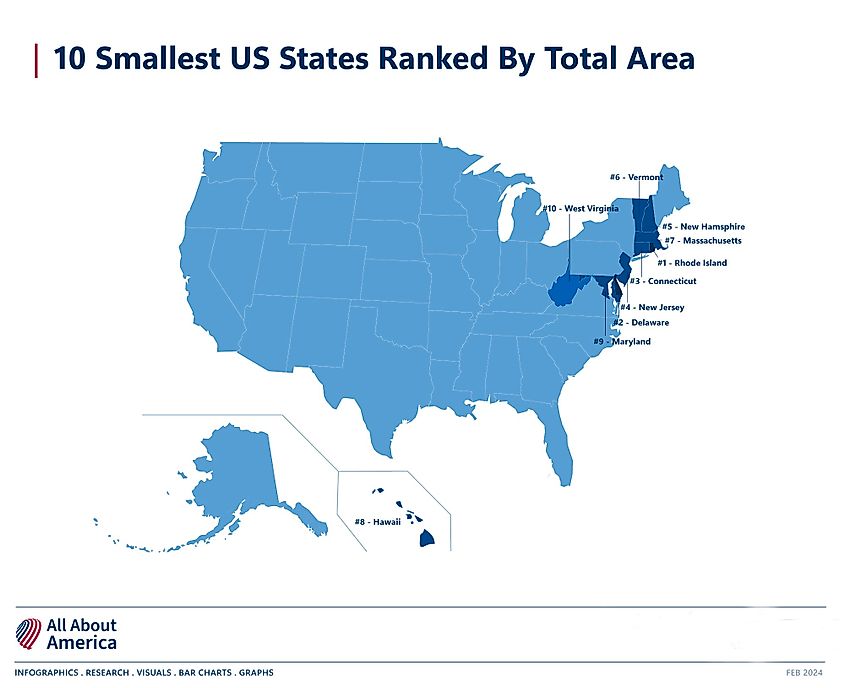
Rhode Island is the smallest state in the United States. Rhode Island has a total area of 3,144 square kilometers, including 438 square kilometers of water.
Delaware,the second smallest state in the country covering 5,130 square kilometers, of which 5,047 square kilometers is land.
Connecticut covers approximately 14,357 square kilometers, making it the third smallest state in the country. Of this total, 12,559 square kilometers is land, with the rest consisting of water.
New Jersey ranks as the fourth-smallest state by total area and the fifth-smallest by land area. It spans 22,591 square kilometers, with 19,047 square kilometers of land. Its water area, covering 3,544 square kilometers, is the 27th largest in the country.
New Hampshire is the fifth-smallest state, covering a total area of 24,214 square kilometers. Its land area of 23,186 square kilometers ranks it as the seventh-smallest state by land area.
Vermont is the sixth-smallest state by total area, spanning 24,923 square kilometers. With a land area of 23,957 square kilometers, it ranks as the eighth-smallest by land area. Its water area covers approximately 989 square kilometers, making it the 46th largest state by water area.
Massachusetts covers a surface area of 27,337 square kilometers, of which 20,306 square kilometers is landmass, and 7,032 square kilometers is water. It has the sixth-smallest land area and 16th largest water area.
Hawaii, one of the two non-contiguous states, is the 8th smallest state by total area, spanning 28,311 square kilometers. It is the fourth-smallest state by land area, covering 16,638 square kilometers of land. Its water area of 11,672 square kilometers (41.2%) is the country’s 13th largest water area.
Maryland covers about 32,133 square kilometers, making it the ninth-smallest state. Its land area of about 25,314 square kilometers is also the country’s ninth smallest. However, the state’s water area of 6,819 square kilometers (21%) is the US' 18th-largest water area.
West Virginia is the 10th-smallest state by both total and land area. It spans about 62,755 square kilometers, of which 62,361 square kilometers is land. At 394 square kilometers, West Virginia has the smallest water area in the country.
| Rank | State | Total Area (km2) |
|---|---|---|
|
1 |
Rhode Island |
3,144 |
|
2 |
Delaware |
5,130 |
|
3 |
Connecticut |
14,357 |
|
4 |
New Jersey |
22,591 |
|
5 |
New Hampshire |
24,214 |
|
6 |
Vermont |
24,923 |
|
7 |
Massachusetts |
27,337 |
|
8 |
Hawaii |
28,311 |
|
9 |
Maryland |
32,133 |
|
10 |
West Virginia |
62,755 |
Area By Region
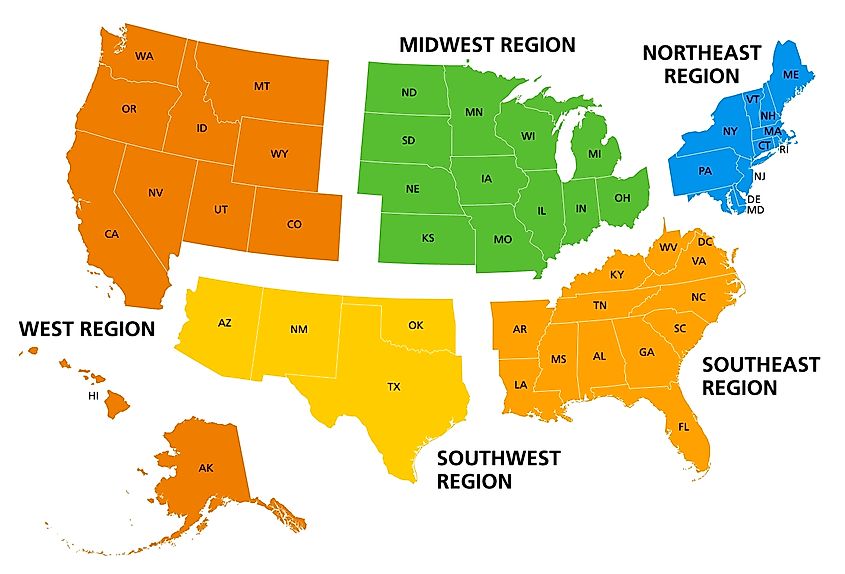
The Western United States is the country’s largest region by total area, covering about 4.9 million square kilometers and constituting nearly half of the contiguous US landmass. This vast region features diverse landscapes, ranging from California's rugged coastlines to the towering peaks of the Rocky Mountains.
Notably, nine of the 10 largest US states by land area—excluding Texas—are found within this expansive region. From Alaska's untamed wilderness to the sun-scorched deserts of Nevada and Arizona, the Western US is a tapestry of natural beauty and cultural richness.
Beyond its scenic splendor, the Western US is a dynamic economic and cultural powerhouse. Its bustling cities, vibrant industries, and pioneering spirit have been instrumental in shaping the nation’s growth and innovation. As the gateway to the Pacific and a defining force in American identity, the Western United States remains a captivating destination for explorers and adventurers.
